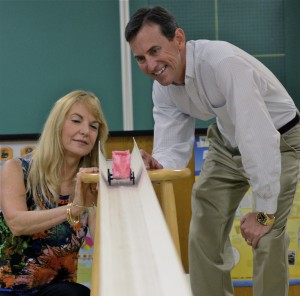Griff Jones, a clinical associate professor of science education in the UF College of Education, knows only too well that the laws of physics apply to everyone.
“I was a high school physics teacher, and I lost a lot of students to car crashes,” said Jones, who spent two decades teaching at UF’s P.K. Yonge Developmental Research School in Gainesville. “Motor vehicle crashes are the No. 1 cause of death among teenagers.”

COE professors Linda and Griff Jones send a hand-made paper test car down a race track Griff Jones designed using sections of a plastic rain gutter.
That’s why Jones and his wife, Linda Jones, a COE associate professor of science and environmental education, co-authored a cover story titled “A Science That Saves Lives” for the January 2013 issue of The Science Teacher, an academic journal sponsored by the National Science Teachers Association.
Their efforts paid off when the Association of American Publishers named their article a finalist in the Distinguished Achievement Award category of the recently held Revere Awards competition. The Revere Awards is the most prestigious recognition program in the learning resource community, according to the Association of Educational Publishers, which once sponsored the awards under a different name.
Receiving accolades for articles isn’t new to the husband-wife research team, but gaining recognition for their story on motor vehicle crashes involving teens meant something special.
“When I worked on my Ph.D. at UF, part of my dissertation was to help the Insurance Institute for Highway Safety write and produce a science education video for students on the understanding of car crashes,” said Griff Jones, who also is director of the COE’s STEM Teacher Induction and Professional Support (STEM TIPS) program. “The number of teen traffic deaths has gone down, but there are still way too many – more than 2,800 a year.”
Together the Joneses not only have kept up with matters related to physical science, but human behavior as well. Their cover story is based on research suggesting that a lack of emotional and cognitive maturity among teenagers increases risky driving practices such as speeding, tailgating and not wearing seat belts.
Their article outlines a “truly life-saving teaching lesson” for high school science educators by combining Internet research with classroom “crash tests” using paper cars designed and built by students; a 6-meter “race track” made from plastic rain gutter sections; a step ladder; and a concrete block that serves as an abrupt “finish line.”
Raw eggs serve as vehicle occupants, and damage to them is measured and recorded at different speeds made possible by placing the track’s starting line on a higher rung of the ladder. Students are challenged to create cars with front ends weak enough to absorb the energy of a high-speed crash, yet strong enough to remain intact and protect the egg.
By project’s end, students have learned to apply two physics concepts used in real-world vehicle safety engineering: momentum and impulse. Momentum is the mass of an object multiplied by its velocity, and measures the difficulty of stopping a moving object. Impulse is the net momentum change during a collision and is measured as the product of the average force exerted on an object.
“It really makes students confront themselves with their misconceptions about their chances of surviving a crash,” said Linda Jones, who serves as coordinator of the COE’s science and environmental education program. “They also learn about the vital role seat belts play in surviving a head-on collision.”
The Joneses’ article can be found at www.nsta.org, the National Science Teachers Association website.
CONTACTS:
Source: Griff Jones, UF College of Education; gjones@coe.ufl.edu;
Source: Linda Jones, UF College of Education; ljones@coe.ufl.edu.
Liaison: Larry Lansford, director, news and communications, UF College of Education; llansford@coe.ufl.edu
Writer: Stephen Kindland, staff writer, UF College of Education; skindland@coe.ufl.edu